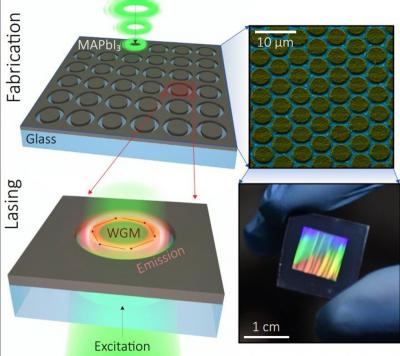An international research team has developed a new method of synthesizing miniature light sources. The method is based on a unique laser which produces millions of nanolasers from a perovskite film in a few minutes. Such lasers look like small disks, work at room temperature and have a tunable emission wavelength from 550 to 800 nm. The high speed and good reproducibility of this method make it promising for the industrial production of single nanolasers as well as whole chains.
 A scheme of the synthesis and operation and an image of the final nanolasers
A scheme of the synthesis and operation and an image of the final nanolasers
Such miniature light sources or nanolasers are required, for example, for producing optical chips that could process information in next-gen devices. However, making such light sources is generally not that easy due to unstable materials, as well as the complex and expensive fabrication methods, which are difficult to control and adjust for industrial production. The scientists from ITMO, the Far Eastern Federal University, Texas University at Dallas, and the Australian National University have found a new way to solve this problem. They have developed a method that may enable the creation of millions of nanolasers from an optically active halide perovskites in a few minutes.
"Such perovskite disks, unlike regular film, act as so-called "whispering gallery" resonators. The spontaneously emitted light in them can be trapped, enhanced, and converted to coherent light. It is very important that we were able to create nanolasers that operate at the same wavelength. Their rough surface suppress all the modes, except one, for which the lasing conditions are most suitable. At the same time, we can control the radiation wavelength by varying the composition of the film," says Sergey Makarov, the head of the Laboratory for Hybrid Nanophotonics and Optoelectronics at ITMO University.

